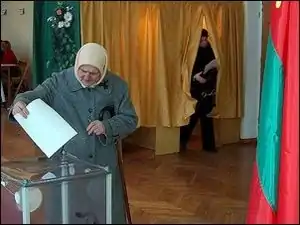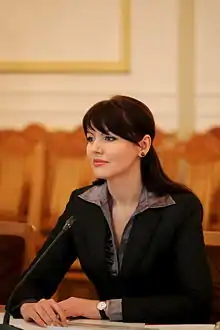Women in Transnistria
Women in Transnistria are women who live in or are from Transnistria (may also be spelled as Transdniestria; and also known as the Pridnestrovian Moldavian Republic, abbreviated as PMR).

| Part of a series on |
| Women in society |
|---|
 |
Population
Based on the census conducted in 2004, 54% of 555,000 people are composed of women; of which 21% of those women are aged over 60 years old.[1]
Employment
Based on the census conducted in 2004, 37% of women have been employed, while 19% were unemployed. Retired women were at 35%.[1]
Education
According to the 2004 census, 50.1% of the population in Transnistria were students in the "professional and higher education" fields. 15.9% of the women have received higher education, but some may not have been able to finished such higher level of education from educational institutions. 31.5% of the women received professional level education. 31.7% of the women received secondary level of education. 8.4 of the women received primary level of education.[1]
Women in politics

Although still a country with limited recognition internationally, and although Freedom in the World 2012 had described that "[w]omen are underrepresented in most positions of authority", the current Transnistrian government includes 8 women and 6 men. Prime Minister of Transnistria (Tatiana Turanskaya) and 3 Deputy Prime Ministers out of 4 are also women (Natalia Nikiforova, Nina Shtanski and Maija Parnas). Women are widely presented in Presidential Administration of Transnistria: both the head of Administration (Nadezhda Baranova)[2] and all the 5 presidential advisors (Alyona Klyus, Nadezhda Zablotskaya, Natalia Garbar, Anna Yanchuk and Galina Sandutsa)[3] are women.
Women are somewhat underrepresented as heads of State Administrations of cities and districts (raions) of Transnistria (only Rybnitsa district is headed by a woman), but are widely presented on posts of deputy heads of State Administrations. Currently 2 deputies out of 5[4] in Tiraspol administration, 2 out of 2[5] in Bendery administration, 2 out of 3[6] in Rybnitsa administration, 2 out of 3[7] in Dubăsari administration, 2 out of 3[8] in Grigoriopol administration and 2 out of 2[9] in Camenca administration are women.
Human trafficking
Some women of Transnistria, including minors, have become victims of domestic violence, human trafficking, and prostitution,[10] which are three of the major problems in the country.[11] Most often, trafficked Transnistrian women and girls are brought to Turkey and the United Arab Emirates.[11]
References
- Women's vulnerability to HIV/AIDS in Transnistria Sociological Research Report 2011 (with link to English and Russian versions)
- Official biography of the Head of Presidential Administration of the Pridnestrovian Moldavian Republic
- Advisors of the President of the Pridnestrovian Moldavian Republic
- Official site of the State Administration of the Tiraspol City and of the Dnestrovsk City of the Pridnestrovian Moldavian Republic
- Official site of the State Administration of the Bendery City of the Pridnestrovian Moldavian Republic
- Official site of the State Administration of the Rybnitsa raion and the Rybnitsa City of the Pridnestrovian Moldavian Republic
- Official site of the State Administration of the Dubossary raion and the Dubossary City of the Pridnestrovian Moldavian Republic
- Official site of the State Administration of the Grigoriopol raion and the Grigoriopol City of the Pridnestrovian Moldavian Republic
- Official site of the State Administration of the Kamenka raion and the Kamenka City of the Pridnestrovian Moldavian Republic
- Transnistria, Freedom in the World 2012, freedomhouse.org
- Trafficking in Persons, A HUMAN SECURITY PERSPECTIVE ON TRANSNISTRIA REASSESSING THE SITUATION WITHIN THE “BLACK HOLE OF EUROPE”, Revue de la Sécurité Humaine/ Human Security Journal – Issue 3 – February 2007, pp. 18-19.
External links
- Lungu, Anna. Peaceful Conflict Transformation in Transnistria, European University Centre for Peace Studies
- Transnistria The Giant Forgotten Cemetery, History and Voices of the Tragedy in Romania and Transnistria, The Nizkor Project
- Transnistria, PEOPLE’S PEACEMAKING PERSPECTIVES MAY 2011
- Gupta, Vidushi (UNHRC journalist). Time to Thrive – Transnistria at Turning Point, 19/05/2013
- Photo exhibition "Women of Transnistria: the diversity and uniqueness", UN WOMEN, saynotoviolence.org